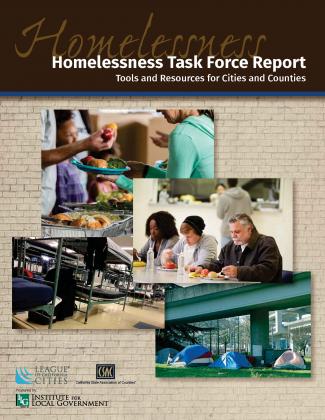As national and state programs fall short of fully addressing
homelessness in California, local governments are coming together
to find solutions for their communities. Collaboration,
cooperation and support at the local level are key to addressing
this crisis. That is why the League of California Cities and the
California State Association of Counties (CSAC) formed the Joint
Homelessness Task Force in late 2016 to examine these issues and
discuss collaborative local solutions to address homelessness.
The task force met over the course of a year to better understand
homelessness in California. The task force wanted to identify not
only known best practices but also promising new practices that
cities and counties are implementing to address homelessness, as
well as the challenges, lessons and gaps communities are facing
in the fight to end it. The culmination of the task force’s work
is a report, developed in partnership with League and CSAC
affiliate the Institute for Local Government, which provides
practical tools for cities and counties in California to use in
addressing homelessness in their communities. Sections of the
report are detailed below, or read the full report
here.
Task Force Members
Co-Chairs:
Jan Arbuckle, Council Member, Grass Valley
Oscar Villegas, County Supervisor, Yolo County
Members:
Stephany Aguilar, Council Member, City of Scotts Valley
Phil Ansell, Director, Homeless Initiative, Los Angeles
County
Robert Bendorf, County Administrator, Yuba County
Jeff Brown, Health & Human Services Director Placer County
Joe Buscaino, Council Member, City of Los Angeles
Cindy Cavanaugh, Director of Homelessness Initiatives, Sacramento
County
Damon Connolly, Supervisor, Marin County
Greg Devereaux, Chief Executive Officer, San Bernardino County,
retired
Sam Dodge, Director of Housing Opportunity, Partnerships and
Engagement, San Francisco
Richard Garbarino, Council Member, South San Francisco
Eric Guerra, Council Member, City of Sacramento
Curtis Hunt, Council Member, City of Vacaville
Kathy Miller, Supervisor, San Joaquin County
Jacky Morales-Ferrand, Director of Housing, City of San Jose
Elizabeth Pianca, Lead Deputy County Counsel, Santa Clara
County
Yibin Shen, Deputy City Attorney, City of Santa Monica
Stacie Spector, Senior Advisor for Housing Solutions, City of San
Diego
James Vanderbilt, Council Member, City of Anaheim
Executive Summary
After steady declines in homelessness from 2007 through 2014, the
number of people without homes in California has now risen for
three consecutive years. This is occurring not just in major
cities and urban areas but also in rural California, in our
heavily forested areas, along our rivers and in our suburban
neighborhoods. Homelessness is no longer confined to our major
metropolitan areas — it has spread to every part of our state.
Distressingly, the increase is due to large increases in the
number of unsheltered homeless people — those who not only have
no place to call home, but are not able to find even temporary
shelter.
The demographics of homelessness are changing, too. Many homeless
individuals struggle with substance abuse disorders and mental
illness. However, domestic violence, lack of affordable housing
and employment opportunities and the cost of health care have
also pushed individuals into homelessness. In addition, thousands
of Californians are displaced every year by natural disasters
such as floods and wildfires.
California is home to 21 of the 30 most expensive rental markets
in the nation and the state does not have enough affordable
housing stock to meet the demand of low-income households. The
state’s 2.2 million extremely low-income and very low income
renter households compete for 664,000 affordable rental homes.
As national and state programs fall short of fully addressing
this issue, local governments are coming together to find
solutions for their communities. Collaboration, cooperation and
support at the local level are key to addressing this crisis.
That is why the League of California Cities and the California
State Association of Counties formed the Joint Homelessness Task
Force in 2016 to examine these issues and discuss collaborative
local solutions to address homelessness.
Local government representatives met over the course of a year to
better understand this issue in California. The task force wanted
to identify not only the known best practices but also promising
new practices that cities and counties are implementing to
address homelessness, as well as the challenges, lessons and gaps
communities are facing in the fight to end it. Details of the
task force’s work are outlined here.
This report provides practical tools for cities and counties in
California to use in addressing homelessness in their
communities. It offers details on how to create a homelessness
plan, identify resources and funding for homelessness and build
support in communities to address homelessness.
To successfully reduce homelessness, local governments must
continue to be creative and must keep moving forward. Each city
and county is unique and may be at very different stages of
addressing homelessness in its community. However, to succeed in
addressing an issue like homelessness, local governments must
learn from each other to collaborate and forge partnerships.
We look forward to the day when every Californian has a path that
leads them home.
Introduction
The January 2017 point-in-time count found that homelessness in
California increased 13.7 percent from 2016–17, making it one of
22 states to see an increase in the number of men, women and
children experiencing homelessness. Statewide, 134,278
Californians were counted as homeless; however, experts agree
that the number of people without housing is three to four times
higher than the point-in-time count. This marks a disturbing
reversal of the trend from 2007–15, which had seen a 16.7 percent
drop in the state’s homeless population. Of those counted in
2017, 68 percent or 91,642 people were unsheltered — by far the
largest homeless population in the nation.
Introduction
Assessing the Cost of Homelessness
Collecting data on the extent of homelessness in California is
critical to addressing the problem. This data allows cities and
counties to understand the demographics and needs of their
homeless populations and track the associated costs. Because
there is no one-size-fits-all solution to homelessness, this data
enables leaders to tailor their approach to the unique needs of
their community. Local governments are collecting
data about their homeless populations in a variety of ways. This
section presents information on how preventative services can
result in cost savings for local governments and a few examples
of software and approaches that local governments statewide are
using to collect data about individuals and families experiencing
homelessness in order to provide better case management.
Assessing the Cost
Funding Options
As a city or county is deciding on the best course of action to
address homelessness in its community, the question of how to pay
for the action will undoubtedly arise. This section focuses on
how cities and counties fund these activities through:
- Federal funding sources;
- State funding sources; and
- Local funding activities.
Funding Options
Existing and Emerging Approaches
Jurisdictions statewide are prioritizing homelessness in their
communities because the benefits of addressing this problem will
help improve the overall health of their communities.
Fortunately, cities and counties can use a number of existing
resources, services and programs to address this complex problem.
The list below provides a starting point to think about what
could work in your community — but each city and county is
unique, and therefore individual approaches should be based on
the community’s unique needs and resources.
Existing and Emerging Approaches
Creating a Homelessness Plan
Whether a city or county has been addressing homelessness for
years or is just starting, having a plan is important. The plan
provides direction for elected officials and staff as they make
decisions about where to dedicate resources and offers a way to
measure progress and success. Whether the plan is for one year or
multiple years, it is likely to involve multiple individual
actions or strategies that may or may not be related. This
section includes a series of questions a city or county should
explore when deciding what strategies to include in its plan and
a template to outline individual strategies. Depending on the
jurisdiction, the plan might include anywhere from two to over
100 individual strategies.
Creating a Homelessness Plan
Homelessness Plan Template
Partnering for Greater Impact
Complex problems such as homelessness are not often solved or
addressed by a single entity. Local governments should consider a
number of key partners when addressing homelessness, such as the
business community, nonprofits, the faith-based community and
philanthropic organizations. In many cases, these entities are
already addressing homelessness — establishing partnerships with
them will allow your city or county to amplify existing efforts
and enhance other organizations’ efforts. This section offers
tips to consider when forming partnerships and examples of
successful partnerships.
Partnering for Greater Impact
Building Community Support
Housing can be a contentious and complicated topic in
communities. For this reason, cities and counties are increasing
their public engagement efforts in the planning process, which
offers many benefits. Engaging the public early in the
decision-making process can help local public agencies avoid
costly pitfalls and mistakes. Involving residents and others in
the process can generate more support for the final decisions
reached by city or county decision-makers. This section offers
tips to and resources to help you better engage your community.
 Menu
Menu


